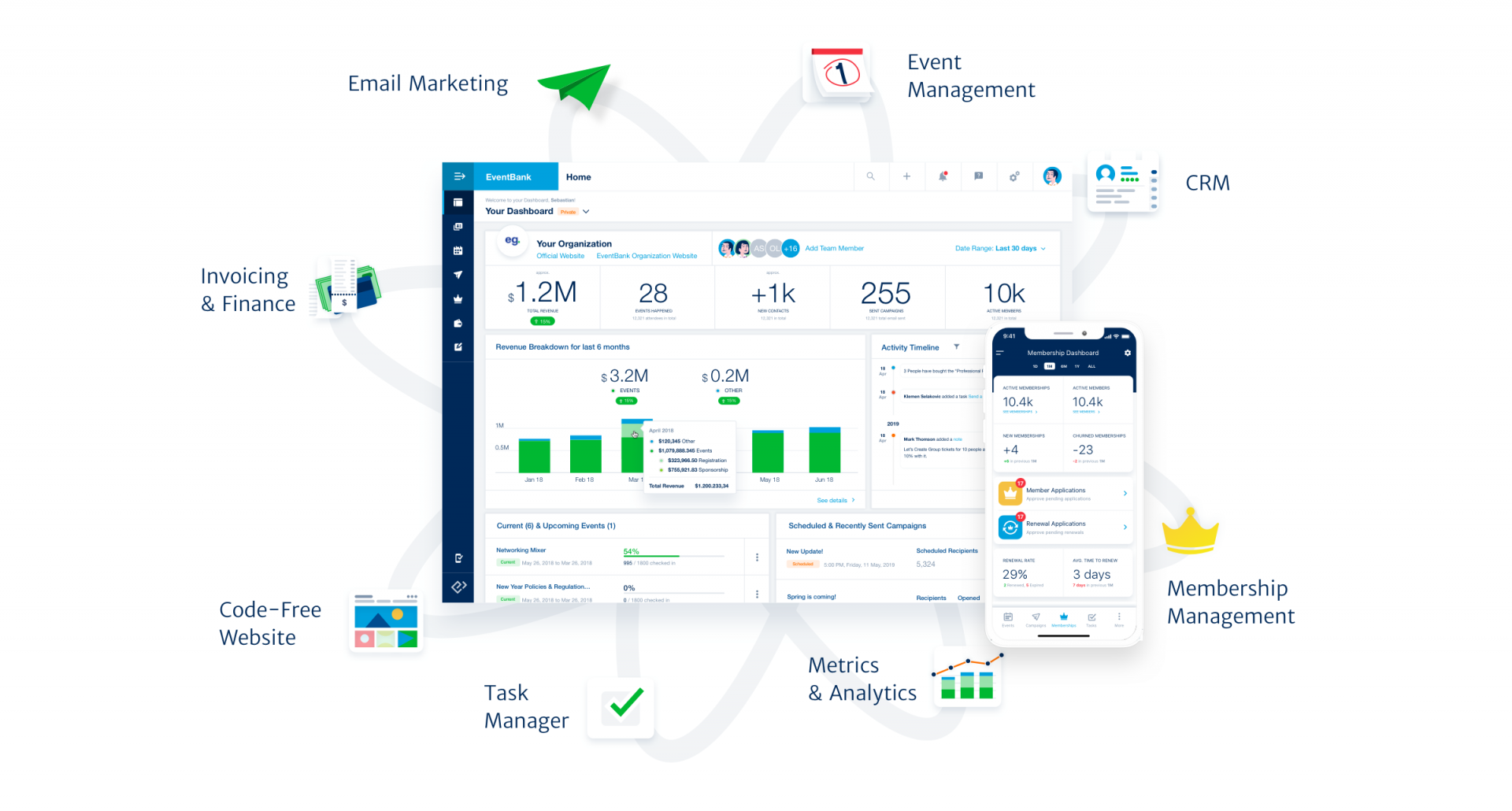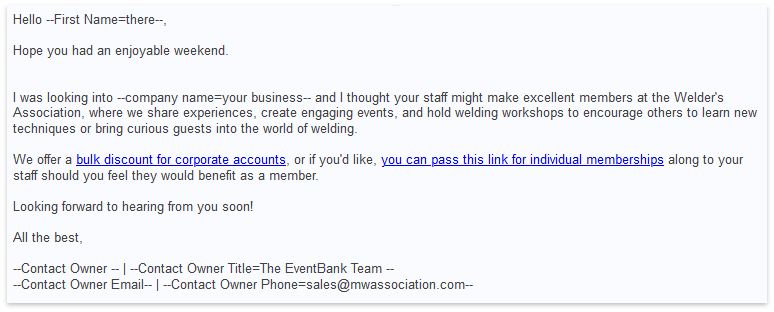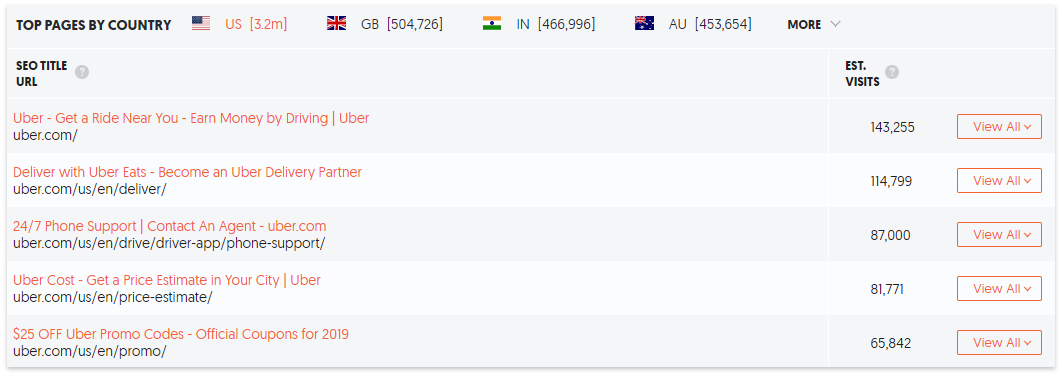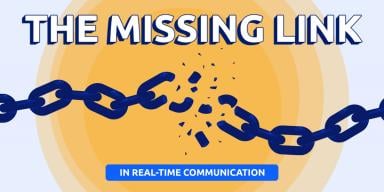
Membership marketing is the main activity your organization should be implementing to drive new members, renew current members, and bring back past members.
Let's dig in.
Table of Contents
- Outline the Member-Journey
- Using the Right Software
- Outbound Member Campaigns
- Inbound Member Campaigns
- New Member Onboarding
- Upgrade Campaigns
- Referral Campaigns
- Renewal Campaigns
Outline Your Members’ Journey
Discovery | Onboarding | Engagement | Renewal

Like a customer journey, a member has a journey of their own at your organization.
A members’ journey is the outlining of every interaction and stage of their involvement with your organization from discovery to renewal of their membership.
Start by identifying your target audience, and then chopping up your organization’s interaction with them into stages so you can better plan for each want and need a person in your journey has.
Broken-down, it looks like this:
- Discovery
- Onboarding
- Engagement
- Renewal
Depending on your organization’s structure and membership these stages may differ, but generally this is what a member in your organization experiences in their lifetime as a member.
Breaking it down in this fashion allows you to better plan what specific marketing campaigns are needed, what content or language is needed, and which marketing method or tool is appropriate.
For the purposes of this article, we’ll stick with the basic stages above.
Using the Right Software
Discovery | Onboarding | Engagement | Renewal

It’s time to start identifying the software, tools, and platforms that can help your organization both personalize and scale-up its ability to promote, engage, and retain members.
There are different tools that may exist in all stages, or just some stages, of the member-journey. The basics include:
- CRM
- Email Marketing
- Event Management Software
- Your Website
- Social Media
- Payment Tools
In your search for the best technology or tools, you might be interested in all-in-one software that combines the majority of these tools into one platform so it’s an easy place to own your data and use it to make smarter member-marketing campaigns.
We’ll be mentioning along with this article which tools to use and where in the journey they would work best.
Outbound Member Campaigns
Discovery | Onboarding | Engagement | Renewal
Software: A CRM, Membership Management Software

In marketing, there are outbound and inbound campaigns that help drive new customers, and in essence, your members are your customers.
In outbound campaigns, these are essentially the cold-calling and cold emailing phase of any business, or any other outreach activity.
This also would include attending events, conferences, and webinars for the purposed of creating relationships with people directly.
Effectively your outbound campaigns are your manual efforts to reach out and convert your target audience into paying members.
There are smarter ways to go about it however that can scale up your outreach.
CRMs + Email Outreach Campaigns
Email campaigns are by far and large one of the most effective ways to reach out to your target audience, provided you have a contact database, to begin with.
It’s important to have a CRM software in place, and there are some options available for free or at reasonable prices.
A CRM is more than just a place to manage your contacts, most retail CRMs like Salesforce, Hubspot, or all-in-one CRMs like Glue Up, have functionality to integrate your contact database with email campaign tools.
Why do you want to integrate?
It helps personalize all your communication at a larger scale.
What does personalization look like?
At an advanced level, a drafted, personalized email looks like this:

You’ll notice some things called “merge tags” or “personalization properties”, or other terms. These are essentially tiny code snippets easily added to email drafts that both personalize emails with any field from their CRM profile.
In layman’s terms, you can refer to their first name in the salutation of the email for any contact’s email that is delivered your email campaign.
This can be expanded to more complex emails like calling out their company name if it’s available, their city name, and more.
If some fields aren’t available you can fall-back to some generic words so long as it fits the sentence grammar.
This means you can craft extremely personalized emails that look genuine and are less likely to be seen as spam by both email firewalls and recipients at first glance.
Open rates should be better, click through, replies, and conversion rates should also be much better.
There’s no real way to personalize without a CRM, so be sure you do some shopping to know which tools work best together. Alternatively, a membership management software solution will also have this functionality.
It’s best to choose a CRM first, and then look for their integrations page, and then follow the trail until you find an affordable tool for you.
Or, just look for an all-in-one software solution for membership-based organizations that integrate natively and internally for a hassle-free user experience for yourself.
Social Media Networking
Fairly simple, start networking on LinkedIn or other social media where your audience is active, and start engaging with the community.
Don’t jump out of the gates offering your organization’s membership, but do engage and make friends.
It’s a great way to exchange contact info earnestly and create more genuine contacts in your database, give great public image for your organization, and also be in-the-know with your audience.
Events & Conference Networking
Software: Event Management Software; A CRM with Business Card Scanning (optional)

Exactly like LinkedIn Networking, you should attend events where your audience is active, or webinars in the case of 2020, and start networking.
Some CRMs even have a feature that lets you take pictures of upwards of 20 business cards laid-out on a table, and the CRM will read each business card and upload the contact data directly to your database.
Don’t forget you can also host your own events that drive people to you, register online, and you can collect their contact information automatically with the use of event management software.
Inbound Member Campaigns
Discovery | Onboarding | Engagement | Renewal
Software: Your Website, Ads Accounts, a CRM
The opposite of outbound campaigns, inbound campaigns is how you pull your audience to you.
From as generic as brand-building for your organization, to as intricate as search engine optimization and online ads.
This can be a bit complicated and technical, so we’ll keep it simple as can be.
Social Media Presence

Like our advice about social media networking in outbound campaigns, it’s important to also create pages or business pages in social media, mainly Twitter, LinkedIn, and Facebook.
Having a presence at an official capacity alone helps bring your audience to you, and creates more channels for growth.
Post through your official account with experiences, tips, guides, reports, and kudos to other users, and you’ll soon grow a social following that can convert into members easily.
Content Creation + SEO

Content creation can be a variety of things, but it’s important to have them with SEO in mind.
SEO is Search Engine Optimization. It’s how you create web pages that can be found easily on search engines like Google, Bing, or Yahoo.
There’s two parts to SEO, how technically healthy the web page is, and how high quality your content is.
Let’s start with content quality, as it’s easy to create and replicate, with some love and care.
Content creation with your competitors. Let’s start with a blogging strategy.
If you want to write a blog post, instead of thinking of ideas of what to write yourself, the best thing to do is find out what your competitors are writing, and which of their blogs are successful.
Free tools like Ubersuggest and SEM Rush are great for helping you crawl competitor sites (as well as your own) and determind which of their articles are performing best, and what keyword they’re targeting.
Just plug in your competitor's website, and it'll show you their top pages and which keywords they target like this:

If we were Lyft, we'd make this type of analysis against our competitor, Uber.
If they keyword is relevant, and it should be, because they’re a competitor, then open their blog article, web page, or landing page, and start researching how they write the content, the purpose, and their flair they use to make it stand out.
Your job now is to simply replicate this content, but do a much better job than them.
If they have a list of 20 hackathon ideas, then you should produce 30 hackathon ideas. More ideas means more value for the reader in this case.
In other cases, try to see google searches through your audience’s eyes, if they want a guide on how to do fundraisers for instance and your competitor has 20 steps to complete it, then you should break it down to 10 steps in whichever way you can do it.
Less steps is more time savings, thus giving value to the reader.
More content doesn’t always mean a higher-performing blog post on search engines, so try to understand what the searcher is looking for before coming up with better competitive content.
Remember to write to give value to the reader in ways that beat your competition, and search engines will reward you with higher ranking.
It doesn’t have to be blogs either, you can create infographics, online calculators, videos, and other cool content on your website too.
Don’t forget to share it on social media when you’ve published your hard work!
Technical SEO is a bit complicated, and if you’re not familiar with it, just relay this great article to your web developer and let them determine the next actions.
Technical SEO needs the basics to rank, and it can help if you know more advanced SEO best practices, but ultimately, as long as you reach bare minimum SEO requirements without hurting your website, high-quality content will always grow.
SEO takes time, and it’s a long-term marketing activity that shouldn’t be given up on early.
It could take up to one year before you see some meaningful traction online, but trust us, as long as you trust in your content, adjust where needed, and update content regularly, you’ll see the fruits of your labor.
Landing Pages + PPC Ads

Landing pages are pages that help funnel visitors to your website from other channels, or even directly through being seen on search engines.
Essentially, these can be replicated website homepages with different or stylized content that’s meant for specific keywords or channels.
Here’s what ours look like.
These pages act to encourage conversion of visitors into new membership registrations, but to get them in this funnel you’ve created, it’s more targeted to just use ads.
Both on Social Media and Search Engines, you can create Ads accounts that let you purchase either posts on social media that reach larger audiences, or search ads that show up at the top of search results for keywords you choose.
These ads target keywords that you might have identified in your SEO research above when targeting competitors.
Thusly, the ads should link to your landing page, which would also consist of a content-focus on those keywords as well.
Here’s a neat guide to creating landing pages, but be sure to think about membership registrations in mind, as more tutorials will have products or demos in mind when showing landing page examples.
Ads are a granular and on-going activity.
Small budgets will have small results, big budgets will have a higher risk of failure. But both can be avoided if you can nurture your ads, identify ads that are failing, and improve and change up content of the ads or landing pages over time.
Soon you should have a working Pay Per Click engine that produces results.
Onboarding a new member is a marketing activity on its own. It may be more intrinsic to your organization’s operations and member services than your actual active marketing strategy.
But all-in-all, the onboarding procedure should be aimed at engaging them early on and getting hyped about being a member. This can get them to:
- Invite their friends to become members too
- Share their hype at becoming a member on social
- Reduce post-payment regret
The on-boarding experience differs from organization to organization, so we’ll leave it up to you to decide the method of on-boarding or what content to use.
Some advice we can give will be to use a membership management software, more than a CRM, it’s likely a part of an all-in-one software solution that helps to manage contacts not as customers, but as members that can track their history of engagement with your organziation, automate reminders, and automatically renew memberships.
There are even platforms out there that can help deliver digital membership cards that help with the member’s interaction with your organization, any physical locations you might own that have access card needs, and are just all-around more convenient to have over physical membership cards. Check out our guide on how digital membership cards work for more details.
Among this, it’s important to also deliver some goodie-bags that help welcome them!
Upgrade Marketing Campaigns
Discovery | Onboarding | Engagement | Renewal
Software: Email Marketing, CRM, SMS, Membership Management Software

This is an optional marketing strategy for organizations with different levels of membership packages.
When creating your membership journey outline, it’s important to identify the time at which you feel it’s appropriate to send campaigns to members that would help them upgrade their membership.
Maybe members who are about to renew their membership in a lower tier could be shown the benefits of not just renewing, but upgrading.
If you have an all-in-one membership software, then you could ideally identify engaged members with a discounted upgrade offer.
For instance, if they attended more than 80% of events you held in a year, you can offer a discounted upgrade.
Or maybe they referred a new member, we’ll get into this in the next section.
Email is by far the easiest method to use to reach out to members with these campaigns as you can easily assign lists made with the requirements you had in your membership software for who is eligible for offers, as well as the timeframe of their membership.
You can use other alternatives to send the campaign like SMS, Social Media posts, and even mailed letters.
Referral Campaigns
Discovery | Onboarding | Engagement | Renewal
Software: Email Marketing, CRM, SMS, Membership Management Software

As we eluded to before this section, a referral program can act as a great catalyst to encourage new member acquisition.
Word of mouth is by far an large the best method of convincing your audience to convert into members.
A referral campaign simply rewards those for spreading the word about your organization, or otherwise encourages more people to talk about it and invite their friends and colleagues to join too.
Marketing for your organization essentially becomes easier at this point.
Now it’s a simple question of what are you willing to give to current members that reward them for referring new members to join?
You’ve had experience in the earlier stages of this guide with outbound, inbound, and upgrade campaigns, so it’s not a question now of how you should reach out to members with a referral program, but simply what is the program itself made of.
Maybe members in a tiered membership organization will enjoy a half-off discount to upgrade to a higher tier if they refer one or more members.
Potentially they can obtain gifts, privileges, or other goodies for referring new members.
The choice becomes yours at this point, and this extends to Renewal campaigns as well.
Renewal Campaigns
Discovery | Onboarding | Engagement | Renewal
Software: Email Marketing, CRM, SMS, Membership Management Software

Very much like referral campaigns, this is a simple marketing strategy that helps encourage members to renew.
Now, ideally you’ve done a great job in the past steps of this guide that you don’t need to use a campaign to encourage renewals, but still, there are some best practices you need to use just in case.
The main best practice that should be used no matter how much your members love your organization, is to have an automatic email or push-notification reminder sent to your members who are within one month (or whichever time-frame you determine) of their membership expiry date.
This will help enter them into an automatic email or push notification journey that can send periodical notifications that their membership is expiring and that they should renew before time runs out.
You will not always be doting over your members manually, and it will be very easy to miss out on members who are close to expiring. Having this on autopilot is a great way to take the pressure off.
More manually, you can send campaigns to past members who expired or canceled with new offers that could encourage them to join once more, however, this is where it's important to have CRM or membership management software that helps identify such lists that contain members who are no longer members.
How are you marketing your member program?
We hope this guide was helpful in giving you ideas to start with, the tools to use, and the strategies to bend to your organization’s needs and help you both obtain and retain members for the foreseeable future.
We mentioned a range of tools in this article, and while it can be nice to do the research, it’s becoming easier and more accessible to just implement an all-in-one membership management software solution inside your organization that has all these tools and software mentioned, and more.
Consider booking a demo with Glue Up, and we’ll show you how our platform helps you manage and market your membership offers to your audience.

![Advantages Of Paperless Board Meetings [+ Tips] Advantages Of Paperless Board Meetings [+ Tips]](/sites/default/files/styles/all_blogs_block_img_384x192/public/image_1578.png?itok=Ah-vnnvq)

![PayPal for Nonprofits: A Guide to Accepting Donations and Managing Your Money [with alternatives] PayPal for Nonprofits: A Guide to Accepting Donations and Managing Your Money [with alternatives]](/sites/default/files/styles/all_blogs_block_img_384x192/public/image_1807.png?itok=ujDAsFNj)